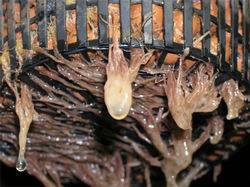Billy Liar
Member
Welcome Back Mr Robinson
Hope you're well
peace
BL

Hope you're well
peace
BL

 ....
....I just made a long ass post about high flow RDWC setups in another thread per the way Heathie rolls MediMary , but I`ve gotta say that there seems to be more and more solutions "beneficial or sterile" to the problems causing crop failure with other RDWC systems , but yet there are still problems regardless...
Heathie put up with Doubled`s constant banter yrs ago about the ultimate RDWC "system" at HG , and in spite of DD`s "knowitall" attitude , Heath still taught him all there was to dial the setup ......and then......
When Heath finally got him to understand how simple it was , he went all high-tech with these big ass "quick disconnect" fittings for fast breakdown and ability to move to the next location , got all complicated with the setup usin all kinds of shit that was NOT required , and Heathie washed his hands of him......
Next thing you know , he`s sellin his shit at the farm as his original brainstorm.......I guess it was , cuz we`d never have any part of all those bell`s and whistles it took for his so-called "dialage".....
Medi......I ran SWC for over 8 yrs with krusty buckets , and I assure you that GH 3 part , lil SM-90 , and silicablast for stem wall strength was all I used , cuz in krusty buckets the plants would grow so fast that limbs would snap from veg weight , much less bloom swellage........
No bene`s , no sterility ,.......Hell.......We tried ta keep "Chloramine/Chlorine" OUT of our juice regimen , and did well.........Now Chlorine and Chloramine are supposedly "beneficial" for crop failure prevention ?.......H202/Peroxide too ?........
We never dealt with such problems and yields spoke for themselves.......not sure what`s happenin with the new system`s these days....
Heath sold me on lower ppm`s , but I`ve never been one to go with the hype of anything but base nutes , so we`ve always seen eye to eye......
Not tryin ta jack my buddy`s thread , but rather answer questions exactly like I know he would........Never foliared a plant in my life , nor heard first hand of him doin it either.....
I`ve seen Heath run several diff nute lines , but no additives or adjustments of any sort........less is more....
Hell......Haven`t seen him run over 7-800 ppm`s in over a decade while results speak for themselves.........
Waitin on yer "Aero" grow Heathie....I know you`ll make some jaws drop as usual...
Peace......Freds.........

root rot is non existent for me!
its the algae that sometimes pops up that i have problems with, I think a lot of folks don't understand(because their water is not effected in their part of the world,and they have never seen anything like this, so since the roots are brown they guess its rot.),
don't mean that in a bad way ofcourse
I personally have not seen any folks in canada or uk ever have this problem.
(not saying it hasnt happened though)
I promise you this is not root rot,this is exactly what I get sometimes.
when the algae hits me, generally other growers in my area also get hit.
You can use physan20, and knock it out, but I would rather go about things in a preventive manner, and thats why i ask about the sterile route/ beneficial microbes.
and this:Pythium has an optimum temperature range for infection of plants, this is generally between 20 - 30C (68 - 86 F), although infection can occur outside this range when damaged plant tissue is available for rapid colonisation by the pathogen
so neglect of your cuttings and seedlings, or your nursery area, can lead to probs..The best preventative measure against Pythium attack is a healthy, rapidly growing plant as this is an opportunist pathogen and will enter at the site of tissue injury or if the plants are overly succulent, weakened or stressed for some reason. Often root damage during the seedling stage as plants are introduced to the hydroponic system is a danger time for Pythium infection. Pythium is of greatest threat during the seed germination and seedling development stage when plants are most vulnerable to attack, and adequate control and elimination of the pathogen during this stage is the best preventative measure of Pythium control in hydroponic systems. Strong healthy plants will develop resistance to Pythium attack during the seedling stage and this will prevent problems at a later stage of growth.
